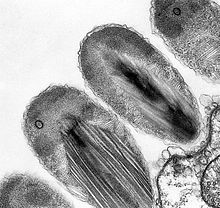| Verrucomicrobiota | |
|---|---|

| |
| Transmission electron micrograph of stage II epixenosomes. | |
| Scientific classification | |
| Domain: | Bacteria |
| Superphylum: | PVC superphylum |
| Phylum: | Verrucomicrobiota Hedlund 2021[1] |
| Classes | |
| Synonyms | |
| |
Verrucomicrobiota is a phylum of Gram-negative bacteria that contains only a few described species. The species identified have been isolated from fresh water, marine and soil environments and human faeces. A number of as-yet uncultivated species have been identified in association with eukaryotic hosts including extrusive explosive ectosymbionts of protists and endosymbionts of nematodes from genus Xiphinema, residing in their gametes.[2][3] The verrucomicrobial bacterium Akkermansia muciniphila is a human intestinal symbiotic bacterium that is considered as a promising probiotic.[4]
Verrucomicrobiota are abundant within the environment, though relatively inactive.[5] This phylum is considered to have two sister phyla: Chlamydiota (formerly Chlamydiae) and Lentisphaerota (formerly Lentisphaerae) within the PVC superphylum.[6] The Verrucomicrobiota phylum can be distinguished from neighbouring phyla within the PVC group by the presence of several conserved signature indels (CSIs).[7] These CSIs represent unique, synapomorphic characteristics that suggest common ancestry within Verrucomicrobiota and an independent lineage amidst other bacteria.[8] CSIs have also been found that are shared by Verrucomicrobiota and Chlamydiota exclusively of all other bacteria.[9] These CSIs provide evidence that Chlamydiota is the closest relative to Verrucomicrobiota, and that they are more closely related to one another than to the Planctomycetales.
Verrucomicrobiota might belong in the clade Planctobacteria in the larger clade Gracilicutes.[10]
In 2008, the whole genome of Methylacidiphilum infernorum (2.3 Mbp) was published. On the single circular chromosome, 2473 predicted proteins were found, 731 of which had no detectable homologs. These analyses also revealed many possible homologies with Pseudomonadota.[11][12]
- ^ Oren A, Garrity GM (2021). "Valid publication of the names of forty-two phyla of prokaryotes". Int J Syst Evol Microbiol. 71 (10): 5056. doi:10.1099/ijsem.0.005056. PMID 34694987. S2CID 239887308.
- ^ Coomans A, Vandekerckhove TT, Claeys M (1 January 2000). "Transovarial transmission of symbionts in Xiphinema brevicollum (Nematoda: Longidoridae)". Nematology. 2 (4). Brill: 443–449. doi:10.1163/156854100509303. eISSN 1568-5411. ISSN 1388-5545.
- ^ Vandekerckhove TT, Willems A, Gillis M, Coomans A (2000). "Occurrence of novel verrucomicrobial species, endosymbiotic and associated with parthenogenesis in Xiphinema americanum-group species (Nematoda, Longidoridae)". International Journal of Systematic and Evolutionary Microbiology. 50 (6). Microbiology Society: 2197–2205. doi:10.1099/00207713-50-6-2197. ISSN 1466-5034. PMID 11155997.
- ^ Zhang, Ting; Li, Qianqian; Cheng, Lei; Buch, Heena; Zhang, Faming (November 2019). "Akkermansia muciniphila is a promising probiotic". Microbial Biotechnology. 12 (6): 1109–1125. doi:10.1111/1751-7915.13410. ISSN 1751-7915. PMC 6801136. PMID 31006995.
- ^ White, Richard Allen; Bottos, Eric M.; Roy Chowdhury, Taniya; Zucker, Jeremy D.; Brislawn, Colin J.; Nicora, Carrie D.; Fansler, Sarah J.; Glaesemann, Kurt R.; Glass, Kevin; Jansson, Janet K. (2016-06-28). Langille, Morgan (ed.). "Moleculo Long-Read Sequencing Facilitates Assembly and Genomic Binning from Complex Soil Metagenomes". mSystems. 1 (3): e00045–16. doi:10.1128/mSystems.00045-16. ISSN 2379-5077. PMC 5069762. PMID 27822530.
- ^ Cho J, Vergin K, Morris R, Giovannoni S (2004). "Lentisphaera araneosa gen. nov., sp. nov, a transparent exopolymer producing marine bacterium, and the description of a novel bacterial phylum, Lentisphaerae". Environ Microbiol. 6 (6): 611–21. Bibcode:2004EnvMi...6..611C. doi:10.1111/j.1462-2920.2004.00614.x. PMID 15142250.
- ^ Gupta RS, Bhandari V, Naushad HS (2012). "Molecular Signatures for the PVC Clade (Planctomycetes, Verrucomicrobia, Chlamydiae, and Lentisphaerae) of Bacteria Provide Insights into Their Evolutionary Relationships". Front Microbiol. 3: 327. doi:10.3389/fmicb.2012.00327. PMC 3444138. PMID 23060863.
- ^ Gupta RS (2016). "Impact of genomics on the understanding of microbial evolution and classification: the importance of Darwin's views on classification". FEMS Microbiol Rev. 40 (4): 520–53. doi:10.1093/femsre/fuw011. PMID 27279642.
- ^ Griffiths E, Gupta RS (2007). "Phylogeny and shared conserved inserts in proteins provide evidence that Verrucomicrobia are the closest known free-living relatives of chlamydiae". Microbiology. 153 (Pt 8): 2648–54. doi:10.1099/mic.0.2007/009118-0. PMID 17660429. S2CID 2094762.
- ^ Wagner, M; Horn, M (2006). "The Planctomycetes, Verrucomicrobia, Chlamydiae and sister phyla comprise a superphylum with biotechnological and medical relevance". Current Opinion in Biotechnology. 17 (3): 241–9. doi:10.1016/j.copbio.2006.05.005. PMID 16704931.
- ^ Hou, S; Makarova, KS; Saw, JH; Senin, P; Ly, BV; Zhou, Z; Ren, Y; Wang, J; Galperin, MY; Omelchenko, Marina V; Wolf, Yuri I; Yutin, Natalya; Koonin, Eugene V; Stott, Matthew B; Mountain, Bruce W; Crowe, Michelle A; Smirnova, Angela V; Dunfield, Peter F; Feng, Lu; Wang, Lei; Alam, Maqsudul (2008). "Complete genome sequence of the extremely acidophilic methanotroph isolate V4, Methylacidiphilum infernorum, a representative of the bacterial phylum Verrucomicrobia". Biology Direct. 3: 26. doi:10.1186/1745-6150-3-26. PMC 2474590. PMID 18593465.
- ^ Ludwig W, Euzéby J, Whitman WB (2008). "Bergey's Taxonomic Outlines: Volume 4 - Draft Taxonomic Outline of the Bacteroidetes, Planctomycetes, Chlamydiae, Spirochaetes, Fibrobacteres, Fusobacteria, Acidobacteria, Verrucomicrobia, Dictyoglomi, and Gemmatimonadetes" (PDF). Bergey's Manual Trust: 15. Archived from the original (PDF) on 2016-11-08. Retrieved 2011-06-22.